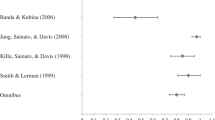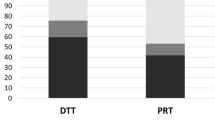Abstract
One of the most problematic behaviors in children with developmental disabilities is noncompliance. Although behavioral research has provided strategies to impact noncompliance, oftentimes the methodologies are consequent techniques, which may not be conducive to implementation by the classroom teacher. In this teacher-designed and implemented study, a sequence of high-probability instructional commands preceded the targeted low-probability command, in an attempt to increase compliance to the low-probability command. Results, discussed within the body of behavioral momentum research, showed an increase in compliance to low-probability classroom commands for a seven year-old student with moderate mental retardation and Down Syndrome. Results are discussed as (a) an effective, antecedent approach to classroom compliance and (b) re-connecting the gap between applied behavioral research and experimentally controlled classroom practice.

Similar content being viewed by others
References
Ardoin, S. P., Martens, B. K., & Wolfe L. A. (1999). Using high-probability instruction sequences with fading to increase student compliance during transitions. Journal of Applied Behavior Analysis, 32, 339–351.
Austin, J. L., & Agar, G. (2005). Helping young children follow their teachers’ directions: The utility of high probability command sequences in pre-k and kindergarten classrooms. Education and Treatment of Children, 28, 222–236.
Barlow, D. H., & Hersen, M. (1984). Single case experimental designs: Strategies for studying behavioral change. Boston: Allyn and Bacon.
Belfiore, P. J., Lee, D. L., Scheeler, M. C., & Klien, D. (2002). Implications of behavioral momentum and academic achievement for students with behavioral disorders: Linking theory with practice. Psychology in the Schools, 39, 171–180.
Brandon, P. K., & Houlihan, D. (1997). Applying behavioral theory to practice: An examination of the behavioral momentum metaphor. Behavioral Interventions, 12, 113–131.
Davis, C. A., & Reichle, J. (1996). Variant and invariant high-probability requests: Increasing appropriate behaviors in children with emotional-behavioral disorders. Journal of Applied Behavior Analysis, 29, 471–482.
Ducharme, J. M., & DiAdamo, C. (2005). An errorless approach to management of child noncompliance in a special education setting. School Psychology Review, 34, 107–115.
Hutchinson, J. M., & Belfiore, P. J. (1998). Adding a sequence of high-preference mathematic problems to increase low-preference mathematics problems performance. Proven Practices, 1, 12–16.
Laraway, S., Snycerski, S., Michael, J., & Poling, A. (2003). Motivating operations and terms to describe them: Some further refinements. Journal of Applied Behavior Analysis, 36, 407–414.
Lee, D. L., (2006). Facilitating academic transitions: An application of behavioral momentum. Remedial and Special Education, 27, 312–317.
Lee, D. L., Belfiore, P. J., Ferko, D., Hua, Y., Carranza, M., & Hildebrand, K. (2006). Using pre and post low-p latency to assess behavioral momentum: A preliminary investigation. Journal of Behavioral Education, 15, 203–214.
Lee, D. L., Belfiore, P. J., & Gormley, S. (in press). I don’t wanna: Creating a momentum of school success. Teaching Exceptional Children.
Lee, D. L., Belfiore, P. J., Scheeler, M. C., Hua, Y., & Smith, R. (2004). Behavioral momentum in academics: Using embedded high-p sequence to increase academic productivity. Psychology in the Schools, 41, 789–801.
Mace, F. C. (1994). Basic research needed for stimulating the development of behavioral technologies. Journal of the Experimental Analysis of Behavior, 61, 529–550.
Mace, F. C., & Belfiore, P. J. (1990). Behavioral momentum in the treatment of escape-motivated stereotypy. Journal of Applied Behavioral Analysis, 23, 507–514.
Mace, F. C., Hock, M. L., Lalli, J. S., West, B. J., Belfiore, P., Pinter, E., & Brown, D. K. (1988). Behavioral momentum in the treatment of noncompliance. Journal of Applied Behavior Analysis, 21, 123–141.
Michael, J. L., (1980). Flight from behavior analysis. The Behavior Analyst, 3, 1–24.
Nevin, J. A., (1996). The momentum of compliance. Journal of Applied Behavior Analysis, 29, 535–547.
Nevin, J. A., Mandell, C., & Atak, J. (1983). The analysis of behavioral momentum. Journal of the Experimental Analysis of Behavior, 39, 49–59.
Olmi, D. J., Sevier, R. C., & Nastasi, D. F. (1997). Time-in/time-out as a response to noncompliance and inappropriate behavior with children with developmental disabilities: Two case studies. Psychology in the Schools, 34, 31–39.
Wilder, D. A., & Carr, J. E. (1998). Recent advances in the modification of establishing operations to reduce aberrant behavior. Behavioral Interventions, 13, 43–59.
Author information
Authors and Affiliations
Corresponding author
Rights and permissions
About this article
Cite this article
Belfiore, P.J., Basile, S.P. & Lee, D.L. Using a High Probability Command Sequence to Increase Classroom Compliance: The Role of Behavioral Momentum. J Behav Educ 17, 160–171 (2008). https://doi.org/10.1007/s10864-007-9054-x
Received:
Accepted:
Published:
Issue Date:
DOI: https://doi.org/10.1007/s10864-007-9054-x




